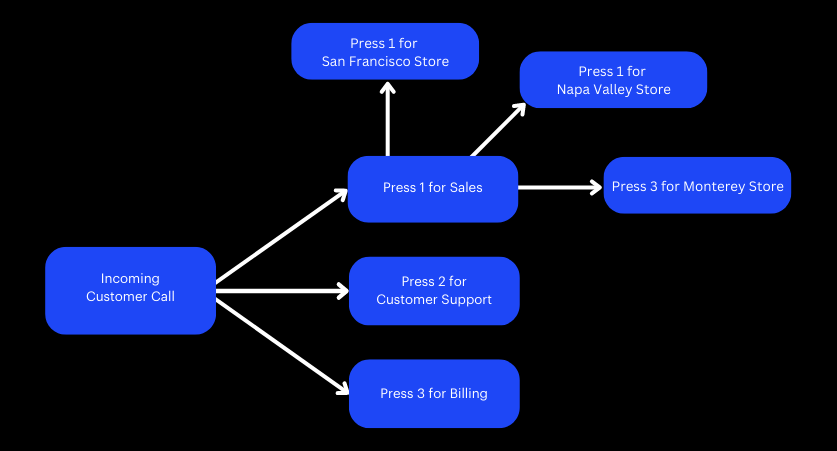Want to connect your callers to the right department every time? Looking for ways to improve efficiency without sacrificing the customer experience?
Interactive Voice Response (IVR) might just be the answer.
If you’ve ever dialed a business number, you may have heard something like:
“Hello and thank you for calling [Company Name]. For sales, please press 1. For customer support, press 2. For billing, press 3. To repeat this message, press 9.”
This is an interactive voice response, and it helps businesses make sure their callers are connected to the right person, which saves everyone time. There are lots of reasons a business might choose to implement an IVR, including to:
- Increase efficiency
- Reduce operational costs
- Position their brand as professional
- Improve brand image
- Increase customer satisfaction
Read on to learn how IVR works, why you should use it, and more.
What is an Interactive Voice Response?
IVR isn’t a new thing—it’s been around since the 1970s. Since then, we’ve witnessed several interesting developments. While most companies still rely on Dual-Tone Multifrequency (DTMF) inputs and voice output systems, next-generation IVR technology relies on speech input and output.
Companies can even implement AI-powered interactive voice responses where callers are not limited by a menu and will be provided with answers based on what they say.
Why should you use IVRs? They can:
- Take care of answering all inbound calls.
- Gather information from your callers.
- Route calls to the right person or department, or even provide callers with the information they’re looking for.
Let’s say you run a chain of supermarkets in California and you have locations in various cities. If someone from Napa Valley dials your number and a representative from your Monterey store answers, the customer might not get the help they need—and your Monterey employee’s time will have been wasted. By setting up an IVR call flow, you can make sure that your callers are routed to the correct location.

You’ve probably used a phone tree like this before. They’re simple, ensure that people get ahold of the department they need, and they save time for everyone involved.
There are two main types of IVR systems.
- Single-Level IVR Systems – Single-Level IVR systems have just one layer of options. If you want to connect your callers directly to your executives, then a single-level IVR is a perfect fit. Single-Level Interactive Voice Response is a good option for small-sized businesses.
- Multi-Level IVR Systems – Multi-Level IVR systems have multiple layers of options. It has a nested structure that businesses should strategically build. The above flowchart is an example of multi-level IVR as after clicking ‘1,’ the caller is provided with more options. Implementing a multi-level IVR system is a great way to unburden your customer service agents or executives across different departments.

3 Benefits of IVR Systems
Now, let’s talk about the benefits of IVR. If you don’t already have one set up, the following points might convince you that it’s time to change that.
1 – Improved Customer Experience
According to Zendesk’s CX Trends 2022 report, over 68% of customers have reported that they feel annoyed upon waiting for their call to be transferred to a different department. The modern consumer craves speed. They want to get the information they’re looking for as quickly as possible—which won’t happen if they’re stuck on hold.
If you don’t have an IVR in place, the employee who picks up the phone might have to manually route the call to the right place. It may not sound like a huge deal—maybe it can be handled in a matter of minutes—but those minutes will add up quickly.
And that’s the best-case scenario. If a customer calls in and the representative who answers doesn’t immediately know where to route the call, the customer may end up feeling extremely frustrated.
With an IVR, this issue isn’t one you’ll have to worry about. You’ll be able to give your customers a fast, convenient call experience, every time.
2 – Personalization
Another thing you should know about the modern consumer? They love personalization. No one likes to feel like they’re talking to a robot who doesn’t know a thing about them or care about their unique situation.
When you connect your IVR system with your CRM database, you can fetch personal information about a customer. If it’s a known caller, you can program your IVR system with a personalized greeting.
And it’s not just about calling your customer by their first name. Your IVR system can fetch additional details about your customers. For example, if they prefer Spanish and if the information is present in the database, you might program your IVR such that it takes that as input and connects your customer with a Spanish representative.
3 – Reduced Operational Costs & Increased Efficiency
Did you know that operator-based calls cost anywhere around $6-12, whereas IVR calls typically cost less than a dollar?
That’s right. It’s not just about improving the customer experience—implementing an IVR can actually reduce your overall operational costs. And because an IVR will help you reduce the frequency of call transfers, you’ll be able to handle more calls no matter how big or small your team may be. More calls means more happy customers, which means more dollars going to your bottom line.
Deliver a Great Customer Experience with IVR
In today’s competitive landscape, wowing your customers isn’t just a nice idea—it’s a necessity. Burnt-out agents and/or inefficient workflows can seriously undermine long-term success. After a single bad experience, over 61% of customers defect to a competitor. The number stands at 76% after two negative experiences.
When your customers dial your number, they don’t just want to be routed to the person who is best equipped to help them. They expect it.
The good news is, by implementing an IVR you can improve the customer experience without wasting time or energy that you don’t have.



